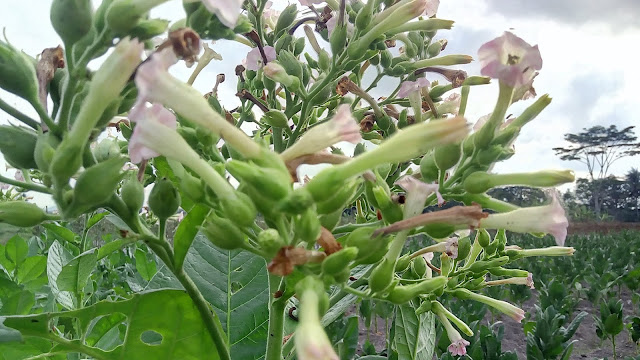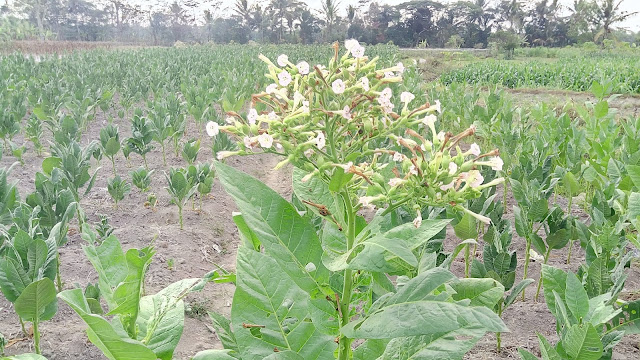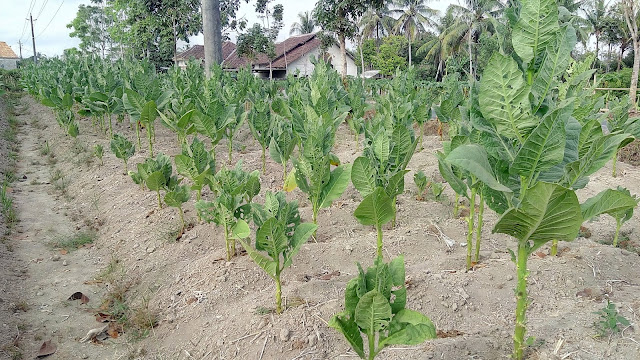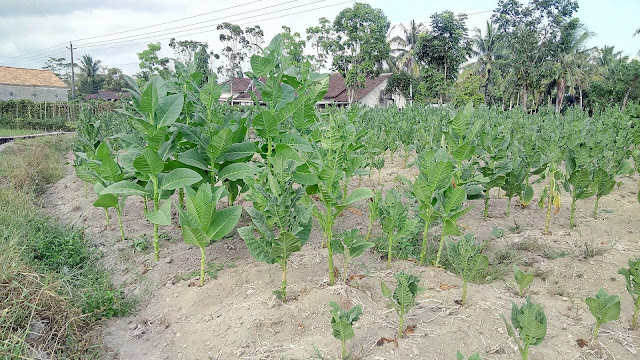The Legendary Leaf Captured Near By Borobudur Temple (Tobacco Plantation)
Hey hey hai ... we meet up again in my new article, and thanks for read this, my pleasure to share it anyway, and this time i want share info and let me say one of my favourite things, it's about botany can be related with the primitive civilization, can be related with the history and etc.
This time i want write about tobacco, let me say the legendary leaf, because it's famous leaf since very long time ago, this plant is a product prepared from the leaves of the tobacco plant by curing them. The plant is the part of the genus Nicotiana and the Solanaceae (nightshade) family. While more than 70 species of tobacco are known, the chief commercial crop is N. Tabacum. The more potent variant N. Rustica is also used around the world.
 |
| Tobacco Flowers Near Borobudur Temple |
Tobacco itself contains the alkaloid nicotine, which is a stimulant, and harmal alkaloids. Died tobacco leaves are aminly used for smoking in cigarettes, cigars, pipe tobacco and flavored shisha tobacco. They can Also be consumed as snuff, chewing tobacco, dipping tobacco and snus.
Traditional use
Tobacco has long been used in the Americas, with some cultivation sites in Mexico dating back to 1400 - 1000 BC. Many Native American tribes have traditionally grown and used tobacco. Eastern North American tribes historically carried tobacco in pouches as a readily accepted trade item, as well as smoking it, both socially and ceremonially, such as to seal a peace treaty or trade aggrement. In some populations, tobacco is seen as a gift from the Creator, with the some ceremonial tobacco smoke carrying one's thoughts and prayers to the Creator.
Cultivation
Tobacco is cultivated similarly to other agricultural products. Seeds were at first quickly scattered onto the soil. However, young plant came under increasing attack from flea beetles (Epitrix cucumeris or E. pubescens), which caused destruction of half the tobacco crop in United States in 1876. By 1890, successful experiments were conducted that placed the plant in a frame covered by thin cotton fabric. Today, tobacco is sown, in cold frames or hotbeds, as their germination is activated by light.
In the United States, tobacco is often fertilized with the mineral apatite, which partially starves the plant of nitrogen to produce a more desired flavor.
After a plants are about 8 inches (20 cm) tall, they are transplanted into the fields, Farmers use to have to wait for rainy weather to plant. A hole is created in the tilled earth with the tobacco peg, either is curved wooden tool or deer antler. After making two holes to the right and left, the planter would to move forward two feet, select plants form his/her bag, and repeat. Various mechanical tobacco planters like Bemis New Idea Setter, and New Holland Transaplanter were invented in the late 19th and 20th centuries to automate the procces. making the hole, watering it, guiding the plant in - all in one motion.
Tobacco is cultivated annually, and can be harvested in several ways. In the oldest method that still used today, the entire plant is harvested at once by cutting, off the stalk at the ground with a tobacco knife. It is then speared onto sticks, four to six plants a stick and hung in a curing barn,. In the 19th century, bright tobacco began to be harvested by pulling individual leaves off the stalk as they ripened. The leaves ripen from the ground upwards, so a field of tobacco harvested in this manner involves the serial harvest of a number of "primings", beginning with the volado leaves near the ground, working to the seco leaves in the middle of the plant. and finishing with the potent ligero leaves at the top. Before this, the corp must be topped when the pink flowers develop. Topping always refers to the removal of the tobacco flower before the leaves are systematically removed and eventually, entirely harvested. As the industrial revolution took hold, harvesting wagons used to transport leaves were equipped with man-powered stringers, an apparatus that used twine to attach leaves to a pole. In modern times, large fields are harvested mechanically, although topping the flower and in soe cases the plucking of immature leaves is still done by hand. Most tobacco in the U.S. is grown in North Carolina, Kentucky and Virginia.
Six Fun Fact About The Tobacco Plant
Traditional use
Tobacco has long been used in the Americas, with some cultivation sites in Mexico dating back to 1400 - 1000 BC. Many Native American tribes have traditionally grown and used tobacco. Eastern North American tribes historically carried tobacco in pouches as a readily accepted trade item, as well as smoking it, both socially and ceremonially, such as to seal a peace treaty or trade aggrement. In some populations, tobacco is seen as a gift from the Creator, with the some ceremonial tobacco smoke carrying one's thoughts and prayers to the Creator.
 |
| Tobacco Flowers Near Borobudur Temple |
Cultivation
Tobacco is cultivated similarly to other agricultural products. Seeds were at first quickly scattered onto the soil. However, young plant came under increasing attack from flea beetles (Epitrix cucumeris or E. pubescens), which caused destruction of half the tobacco crop in United States in 1876. By 1890, successful experiments were conducted that placed the plant in a frame covered by thin cotton fabric. Today, tobacco is sown, in cold frames or hotbeds, as their germination is activated by light.
 |
| Tobacco Plant Near Borobudur Temple |
In the United States, tobacco is often fertilized with the mineral apatite, which partially starves the plant of nitrogen to produce a more desired flavor.
After a plants are about 8 inches (20 cm) tall, they are transplanted into the fields, Farmers use to have to wait for rainy weather to plant. A hole is created in the tilled earth with the tobacco peg, either is curved wooden tool or deer antler. After making two holes to the right and left, the planter would to move forward two feet, select plants form his/her bag, and repeat. Various mechanical tobacco planters like Bemis New Idea Setter, and New Holland Transaplanter were invented in the late 19th and 20th centuries to automate the procces. making the hole, watering it, guiding the plant in - all in one motion.
 |
| Tobacco Plantation Near Borobudur Temple |
Tobacco is cultivated annually, and can be harvested in several ways. In the oldest method that still used today, the entire plant is harvested at once by cutting, off the stalk at the ground with a tobacco knife. It is then speared onto sticks, four to six plants a stick and hung in a curing barn,. In the 19th century, bright tobacco began to be harvested by pulling individual leaves off the stalk as they ripened. The leaves ripen from the ground upwards, so a field of tobacco harvested in this manner involves the serial harvest of a number of "primings", beginning with the volado leaves near the ground, working to the seco leaves in the middle of the plant. and finishing with the potent ligero leaves at the top. Before this, the corp must be topped when the pink flowers develop. Topping always refers to the removal of the tobacco flower before the leaves are systematically removed and eventually, entirely harvested. As the industrial revolution took hold, harvesting wagons used to transport leaves were equipped with man-powered stringers, an apparatus that used twine to attach leaves to a pole. In modern times, large fields are harvested mechanically, although topping the flower and in soe cases the plucking of immature leaves is still done by hand. Most tobacco in the U.S. is grown in North Carolina, Kentucky and Virginia.
Six Fun Fact About The Tobacco Plant
- Thousands of Seeds : Tobacco seeds are tiny, very tiny. One flower has about 3000 seeds. Depending on the variety, you can count between 10,000 and 20,000 seeds per gram, around half a million per ounce. Tobacco cannot be planted directly in the field. The grower has to set seedbeds first, to take care of them and to select the small plants for transplanting. Nowadays, the grower can buy trays with alveoli prepared with soil and one single seed, coated with nutrients.
- Dozens of Leaves : A tobacco plant produces between 20 and 30 leaves, and even more if buds are not removed. They are not all usable. According to the process in the field, mainly if the tobacco plants are topped or not, the grower is going to pick between 10 and 16 leaves.
- A Few Feet : If not topped, the most common grown tobacco plants can grow up to 8 or 9 feet. When shade grown and irrigated, the development is fast and the stalk is weak. Each plant has to be propped up to keep it straight up. On the contrary, some oriental types with very small leaves do not grow over 3 feet.
- The Higher You Get : When growing up from the foot to the tip of a tobacco plant, leaves become darker, thicker and fuller. Therefore, to know the origin of the tobacco is not enough to guess how the cigar is going to taste. The stalk positions of the leaves are essential to the taste!
- Mistaken Identity : The tobacco plant belong to the family of Solanacees (same as potatoes and tomatoes), and to the genus Nicotiana. Grown tobacco for smoking products are classified in the subgenus Nicotiana Tabacum, species Nicotiana Tabacum L. But after decades of gene tampering and uncontrolled hybridations, it is impossible to know exactly what is what! After much research conducted during the 20th century, it seems that all grown tobaccos are coming from 4 original subspecies : Havanensis, Brasiliensis, Virginica and Purpurea.
- Not Only For Smoking : Besides the well known uses of tobacco such as using for snuff, smoking or chewing, there are other uses as well. Some types are used as decorative plants (Petunias). Nicotine extracts are used in pharmacology and perfumery. Nicotine was also to fatten pigs! Tobacco plants are often used in genetical and botanical fundamental research because it is a fast growing plant allowing several generations per year.
Comments
Post a Comment